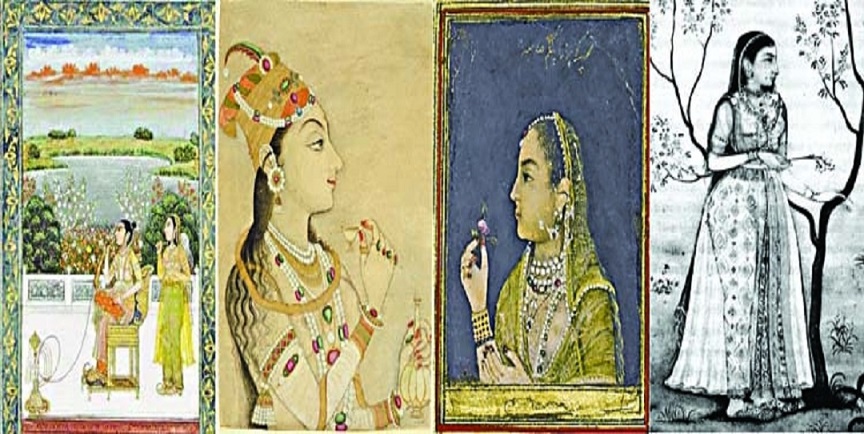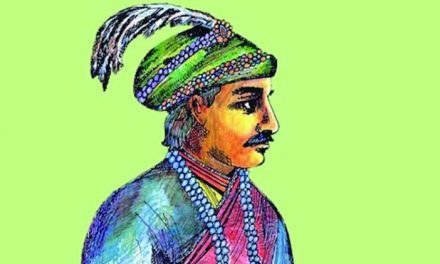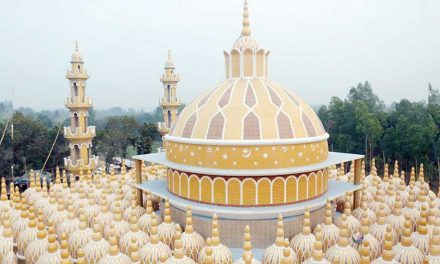From the very beginning, women in the Mughal era had a profound influence on the men they birthed, loved, protected and advised because of who they were, what they did and how they lived out their ambitions and aspirations. Typically, our knowledge of Mughal queens is restricted to Mumtaz Mahal, who inspired the empire’s greatest monument, and Nur Jahan, who helped her husband rule with a firm hand.
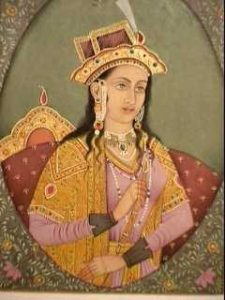
Gulbadan Banu Begum. Image Source: Google
Another important character some of us may recall is Gul Badan Banu Begum, Babur’s daughter, who wrote about the life and times of her courageous father and unfortunate brother, Humayun. Jahanara Begum, daughter of Shah Jahan and sister of Aurungzeb, is also a name that crops up when women of the Mughal era are talked about.
However, if we look into the history of that time carefully, we can notice that historians only gave prominence to the male Mughal rulers although the Mughal women contributed to the Mughal Empire greatly. Women were actively involved in the harem and court politics; their ideologies impacted rulers greatly and many of them were the ‘kingmakers’ who ruled the Mughal world behind the curtains. Besides politics, Mughal architecture was also heavily influenced by their women.
The life of Mughal women was very different during the early days. They had some freedom while the dynasty was still nomadic, but as the empire solidified, their role grew less flexible, although no less powerful. The Mughals were very pragmatic and compassionate about their women; they did not place a supreme worth on the sexual chastity of their women, and divorce and remarriage were not only absolutely accepted, but actively encouraged.
However, most historians have portrayed the life of women in the harems as a very sexualized, secluded domain. Historian Angela Woollacott mentioned how feminist theory has helped shed light on the power dynamics involved in the ‘masculinization of the category “historian”‘ and the resultant exclusion of women who participated in history writing’. One such historian, whose work is the only surviving history written by a woman in 16th century Mughal India is Gulbadan Banu Begum.
Gulbadan Banu Begum was the daughter of Babur, the first Emperor of the Mughal Empire, and Dildar Begum, born in 1523 in Kabul. She was also the sister of Emperor Humayun, and the esteemed aunt of the Emperor Akbar, perhaps the best-known emperor of the Mughal age. She had been witness to the early Mughal rulers -Babur and Humayun and was to see Akbar’s reign too. She was a respected and prominent member of the court whose way with words was admired. She spent her childhood moving between cities in India due to her father’s and later brother’s military campaigns. Fluent in both Persian and Turkish, she was also considered a poet of her time, although none of her works have survived.
Gulbadan had her own chance to present history when Akbar had commissioned the writing of an official history of the early stages of the Mughal empire and his reign. Gulbadan’s work on her brother, Humayun Nama, is a different kind of history. Her writing was from experience, having witnessed the early turmoil that marked her father and brother’s reign. She wrote about the anxieties and pressures of the women in the royal family and even charted the emperors’ travels through the minds of the women in his household.
Her rendition of the story allows us a distinct insight into women’s lives in the Mughal harem. Her focus was on the everyday life of the royal family. Her documentation allows us to reflect and raise questions about the making and functioning of the Mughal Empire, enabling us to focus on an aspect of history that Mughal historians purposely avoided.
Surrounded by powerful men, Gulbadan has somewhat faded into obscurity in the later years, but her contribution to the history of the Mughal Empire cannot be left unnoticed.
Next to Gulbadan Banu Begum, stands Nur Jahan, one of the most powerful female rulers of the 17th century and wife of Mughal Emperor Jahangir.
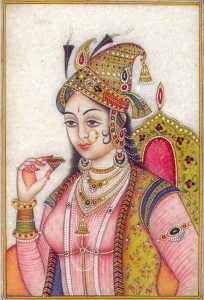
Nur Jahan. Image Source: Google
Nur Jahan’s competence is mainly acknowledged because she was a Mughal Empress but her extraordinary qualities are often neglected and shrouded by her husband’s title. Not many people know of her origin, background or the obstacles she had to face throughout her life. She was not like any other ruler of that time, rather, she was the only female monarch in a male-dominated empire.
Nur Jahan, born as Mehr-un-Nisa, was the perfect combination of a sophisticated, creative, simple-minded, yet witty, energetic, tough and intelligent sovereign. She was married first to Ali QuliIstajlu, a Persian refugee, who was killed in a fracas after being transferred to Burdwan by Jahangir. When she was widowed, she was brought to Agra along with her daughter Ladlii, and was made an attendant to Salima Sultana Begum, Akbar’s wife, and Jahangir’s stepmother. Mehr-un-Nisa stayed in the harem for four years and over the course of that time her skills and creativity made her stand out of the crowd. Her finesse in embroidery and stitching helped her to become a very popular designer for the Mughal ladies. The invention of the Dudámí(flowered muslin) for peshwáz (gowns open in the front), panchtoliah for o?hnís (a new design for veils), bádlah (embroidery with metal strips), kinárí (lace), and farsh-i-chandaní (white cloth for floor covering) are credited to her. Besides clothes, she was also credited with designing gold ornaments with elegant patterns.
In 1611, Jahangir fell in love with her when he met her at Meena Bazar – a new year fair started by Akbar in which the emperor was the only male present while noblewomen, princesses and other female members of the royal harem exhibited brocades, exquisite silks, fine muslins, bejeweled turbans and the like. He proposed immediately and got married later that year. Mehr-un-Nisa, being Jahangir’s 18th and last wife, was given the title of Nur Mahal or Light of the Palace and later Nur Jahan or Light of the World, by Jahangir. She was also given the title of Badshah Begum. Her contributions in the harem exceptionally features her creative aspects.
Mughal women were often trained in basic warfare and knew how to use swords or hunt, and Nur Jahan, again, was no exception. In fact, she excelled in this sector and often accompanied Jahangir during tiger hunts. Unlike any other wife of Jahangir, Nur Jahan escorted him to most places. She assisted her husband in his pursuit of nude art and painting since she had a keen eye and refined taste of culture.
She is also given credit for distilling and popularizing the use of attar, essence of roses, which was originally discovered by her mother Asmat Begum. She was a great patron of architecture too, and built many beautiful palaces, gardens and mosques, including the Patthar Masjid mosque at Srinagar. The Indo-Persian architecture of the glorious Taj Mahal in Agra was inspired by her design of the tomb she built for her father Mirza Ghias Beg.
When Jahangir fell sick, which was often, he gave Nur Jahan permission to take over the government responsibilities while she monitored his health too. Nur Jahan was the only Mughal empress in whose name gold coins were struck, with the other side bearing her husband’s. She would even appear with Jahangir for jharokha darshan, a tradition that Akbar started in which the emperor would show himself at the window after dawn prayers every day to give the common people an audience. No other woman of that empire received the privilege of being a co-sovereign other than Nur Jahan and she proved to everyone that she deserved this respect.
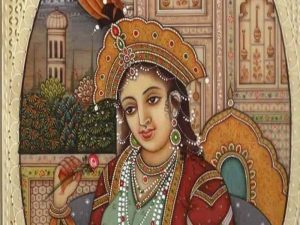
Mumtaz Mahal. Image Source: Google
Next comes one of the most beloved women of the Mughal era- Mumtaz Mahal. Mughal Emperor Shah Jahan who built the Taj Mahal, a wondrous monument, in dedication to the love, beauty, and life of Mumtaz Mahal, had succeeded in his lifetime in his dire wish to immortalize the name of Mumtaz Mahal, his third wife.
Mumtaz Mahal was born in 1593 as Arjumand Banu Begum, a princess from Persian nobility, daughter of a wealthy Persian noble Abul-Hasan Asaf Khan, who held high office in the Mughal court, and niece of Mughal Empress Nur Jahan. So enthralling was her beauty that Shah Jahan fell in love with her at first sight. Mumtaz Mahal was Shah Jahan’s trusted companion, traveling with him all over the Mughal Empire. He trusted her so far that he even gave her his imperial seal, the MuhrUzah. Mumtaz was portrayed as the perfect wife with no aspirations to political power. She was a great influence on the Emperor, apparently often intervening on behalf of the poor and destitute.
She enjoyed watching elephant and combat fights performed for the court. Like most Mughal women of noble birth, Mumtaz also commissioned architecture in the Mughal court and devoted some time to a riverside garden in Agra. In their nineteen years of marriage, they had thirteen children together, seven of whom died at birth or at a very young age.
In 1630 Mumtaz Mahal accompanied Shah Jahan who was fighting during a military campaign on the Deccan plateau. She did not know it would be her last trip. She died in 1631, giving birth to her 14th child, and was buried in Burhanpur at the place of her death. But this tomb was temporary. Shah Jahan decided, ravaged by the sorrow, to build for his wife a mausoleum as beautiful as was his love for her. He put 22 years to this task and partially ruined the treasure of the Mughals, but the case was up to his expectations. The Taj Mahal was born.
Today, the Taj Mahal stands as the ultimate monument of love, and a homage to her beauty and life. It is a celebration of love and the marital bond shared between the Emperor and his beloved Empress; it also celebrates marriage and love as gifts from God. Quranic calligraphy is omnipresent; the gardens represent paradise. Shah Jahan’s love for Mumtaz Mahal inspired what has been described as “simply the most exquisite building in the world”. Through the Taj, Mahal’s legacy lives on.
Visitors of the tomb are uplifted spiritually by the experience of viewing the sublime, and dare to imagine that if love could produce what they perceive to be as a piece of heaven on earth, perhaps humanity can transcend other limitations too, and create a just, harmonious and peaceful world. The tomb has a mosque on one side and a guest house on the other.
If Mumtaz had not lived, if her husband had not cherished her memory as much as he did, the world would lack a jewel in the crown of human artistic and creative achievement.
Mumtaz Mahal also greatly contributed to Mughal history by giving birth to another jewel, her eldest daughter, Jahanara Begum- the Sufi Mughal princess.
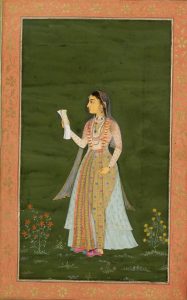
Jahanara Begum. Image Source: Google
At the tender age of seventeen, Jahanara Begum received the title “Padshah Begum”, First Lady of the Mughal Empire, after the untimely demise of her mother. Half of her mother’s property, worth ten million at that time, was given to her. The royal seal was also entrusted to her and overtime Jahanara became one of the wealthiest women of the empire.
Many villages and lands were granted to her and she owned several gardens too, including Bagh-i-Jahanara, Bagh-i-Nur, Bagh-i-Safa. Jahanara was also one of the few Mughal women who owned a ship. Her ship, Sahibi, which she constructed herself, was docked at her port in Surat and carried trade with the Dutch and the English. Besides being affluent, she was bestowed with the kindest heart by God. When her ship set sail for its first journey, she ordered that the ship should make voyages to Mecca and Medina every year with fifty Koni (7550 pounds) of rice for distribution among the destitute and needy. She was renowned for making incredible charitable donations and made great monetary contributions in support of learning and the arts.
Jahanara herself was a keen learner. Akin to her brother, Dara Shukoh, she was inclined towards Sufism and was a disciple of Mullah Shah Badakhshi. He introduced her to the Qadiriyya Sufi order to satiate her spiritual longings. She made such progress on the Sufi path that Mullah Shah would have named her the successor in the Qadiriyya, if the rules allowed. One of Jahanara’s books, ‘Risalah-i-Sahibiyah’ was based on her spiritual journey with Mullah Shah, where she expressed her affection towards the Qadiriyya Sufi order. She is credited with writing ‘Mu’nis al-Arvah’, the biography of Sufi saint and Chishtiya order founder Moinuddin Chisti which is widely acclaimed for its literary craftsmanship.
Jahanara too, like many in her family, faced turmoil when the battle for succession began. She openly sided Dara Shukoh, who she was more attached to than her other brothers, Shah Shuja, Murad Baksh, and Aurangzeb. After Aurangzeb sat on the imperial throne, he sent his father Shah Jahan to court imprisonment in Agra fort. Jahanara also went to voluntary house arrest with her father which led her to become his closest companion and aide. She devoted all her time to her father and cautiously watched after his safety till his death. After Shah Jahan’s demise, Jahanara returned to the courtly life under Aurangzeb, who restored her title of “Padshah Begum”.
Jahanara Begum was a paragon of virtues: well-educated, well-versed in statecraft, even-tempered, beautiful. Her knowledge from Sufism reflected in her personality, which can be considered saint-like or angelic. Following her father’s footsteps, Jahanara contributed to several architectural gems. She built mosques, gardens, inns, and bazaars all over the subcontinent. Her greatest contribution was Delhi’s beautiful Chandni Chowk. Alongside the chowk, Jahanara is highly credited for her great monetary contribution in the construction of the famous Jami Masjid in Agra.
She was unlike any other Mughal princess because whatever she was and achieved, she did them all by herself- without a spouse. Despite being the wealthiest woman of that time, Jahanara did not build a lavish tomb for herself like her mother Mumtaz Mahal. Her tomb is simple yet elegant, built in the dargah of Hazrat Nizamuddin Auliya. Today, the tomb of one of the most powerful and influential princesses of the Mughal Empire is a place for keeping mentally challenged women. There are many female characters in Mughal history that deserve to receive the utmost respect for their contributions, among these four women must receive the highest tiers. They are an important part of a fuller understanding of what was, at its zenith, the grandest empire the world had ever known.

